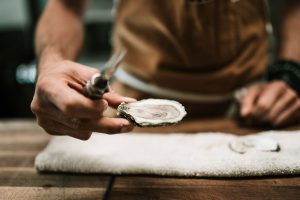 Among the stark images of climate change (polar bears struggling for footing on shrinking ice floes, citizens of Denmark frying eggs on the sidewalk) many fundamental problems are being pushed to the background. One of the trickiest subjects is the issue of our fish and shellfish supply. As the oceans warm, some species of fish are altering their migratory patterns while others are locked in a fight for survival.
Among the stark images of climate change (polar bears struggling for footing on shrinking ice floes, citizens of Denmark frying eggs on the sidewalk) many fundamental problems are being pushed to the background. One of the trickiest subjects is the issue of our fish and shellfish supply. As the oceans warm, some species of fish are altering their migratory patterns while others are locked in a fight for survival.
When it comes to shellfish—particularly those varieties that gourmands love to eat raw—the situation becomes more complex. In bodies of water without significant tidal activity, such as the Gulf of Mexico, the warming trend is having a disturbing effect. The Gulf is warmer than other oyster habitats to begin with; when you add in a half-dozen tropical storms and/or hurricanes each year, it’s fair to say that shellfish production in Florida and other coastal areas is under siege. In places with intertidal activity, such as the Pacific Northwest, things are more encouraging: research suggests that extremes of water temperature might actually be strengthening the ability of oysters to spawn and survive.
Thus, it’s no wonder that we’re seeing more Pacific oysters on restaurant menus, although prices are skyrocketing. This is true of oyster prices in general. While it’s still possible to find a dozen oysters in New Orleans for under $24, the cost of consuming raw shellfish seems to be increasing everywhere else. In the restaurants that offer them (roughly 9% of the U.S. total), it’s not unusual to pay $36 or even $48 for a dozen bivalves.
 One of the frequently overlooked aspects of our warming oceans is the possibility of bacterial contamination. Under any circumstances, eating raw shellfish entails risk; as waters warm, however, it becomes easier for bacteria to replicate. The problem is complicated by the inability to detect contamination by a visual inspection. While the incidence of contamination in oysters remains low, that’s no consolation to anyone who has contracted food poisoning from eating them.
One of the frequently overlooked aspects of our warming oceans is the possibility of bacterial contamination. Under any circumstances, eating raw shellfish entails risk; as waters warm, however, it becomes easier for bacteria to replicate. The problem is complicated by the inability to detect contamination by a visual inspection. While the incidence of contamination in oysters remains low, that’s no consolation to anyone who has contracted food poisoning from eating them.
Students of culinary history look back with envy on periods such as La Belle Epoque in Paris, when it was customary for bon vivants to begin a meal by eating two or three dozen oysters. We may always have Paris, but the future of oyster consumption is looking problematic.
Mark Spivak specializes in wine, spirits, food, restaurants and culinary travel. He is the author of several books on distilled spirits and the cocktail culture, as well as three novels. His latest release, Impeachment, is now available on Amazon.
The post The Ghost of Oysters Past appeared first on Palm Beach Illustrated.
